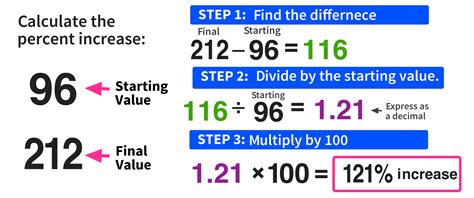How to Determine Percentage Increase: A Simple Guide
Calculating percentage increase is a fundamental skill with broad applications, from analyzing financial data to understanding population growth. Whether you're tracking your investment portfolio or assessing the success of a marketing campaign, mastering this calculation is crucial. This guide will walk you through the process, providing clear steps and examples to help you confidently determine percentage increase in any scenario.
Understanding the Basics of Percentage Increase
Before diving into the calculations, let's clarify the core concept. Percentage increase represents the relative change between an initial value and a final value, expressed as a percentage. It shows how much a value has grown proportionally. The formula is straightforward, but understanding the components is vital.
Key Components:
- Original Value: This is the starting point, the initial amount before any increase.
- New Value: This is the final amount after the increase has occurred.
- Increase: The difference between the new value and the original value (New Value - Original Value).
Calculating Percentage Increase: Step-by-Step Guide
Here's a step-by-step guide to calculate percentage increase, accompanied by a clear example:
1. Find the Increase: Subtract the original value from the new value.
Example: Let's say your initial investment was $100 (Original Value), and it grew to $150 (New Value). The increase is $150 - $100 = $50.
2. Divide the Increase by the Original Value: This step determines the increase as a proportion of the original value.
Example: $50 (Increase) / $100 (Original Value) = 0.5
3. Multiply by 100 to Express as a Percentage: This converts the proportion to a percentage.
Example: 0.5 * 100 = 50%
Therefore, the percentage increase in your investment is 50%.
Handling Percentage Decrease
While this guide focuses on increase, understanding how to calculate percentage decrease is equally important. The process is very similar:
- Find the Decrease: Subtract the new value from the original value (Original Value - New Value).
- Divide the Decrease by the Original Value.
- Multiply by 100 to express as a percentage. The result will be a negative percentage, indicating a decrease.
Practical Applications of Percentage Increase Calculations
Understanding percentage increase has numerous real-world applications:
- Finance: Tracking investment returns, analyzing stock market performance, comparing interest rates.
- Business: Measuring sales growth, assessing marketing campaign effectiveness, analyzing cost increases.
- Science: Studying population growth, analyzing experimental data, tracking environmental changes.
- Everyday Life: Comparing prices, understanding discounts, calculating tips.
Mastering Percentage Increase for Data Analysis
By consistently applying these steps, you’ll develop a strong understanding of percentage increase calculations. This skill is invaluable for interpreting data, making informed decisions, and communicating your findings clearly and effectively. Remember to always clearly identify the original and new values to ensure accuracy in your calculations. Practice regularly with various examples to solidify your understanding.
